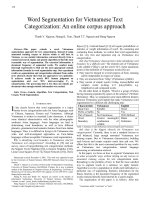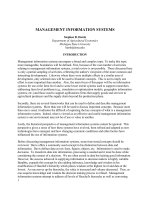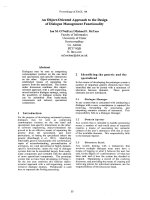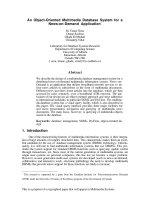- Trang chủ >>
- Đại cương >>
- Kinh tế vĩ mô
developing chemical information systems an object oriented approach using enterprise java
Bạn đang xem bản rút gọn của tài liệu. Xem và tải ngay bản đầy đủ của tài liệu tại đây (4.19 MB, 349 trang )
Developing Enterprise Java Applications with J2EE and UML
by Khawar Zaman Ahmed, Cary E. Umrysh
• Paperback: 288 pages ; Dimensions (in inches): 0.66 x 9.28 x 7.32
• Publisher: Addison-Wesley Pub Co; ISBN: 0201738295; 1st edition
(December 15, 2001)
• Average Customer Review: Based on 6 reviews.
Table of Contents
Copyright 6
Dedication 7
Foreword 8
Preface 10
Intended Audience 10
How to Use This Book 11
Chapter Summaries 12
Conventions 13
Acknowledgments 15
Chapter 1. Introduction to Enterprise Software 17
What Is Enterprise Software? 17
Evolution of Enterprise Software 20
Enterprise Software and Component-Based Software 22
Summary 23
Chapter 2. Introduction to the J2EE 24
What Is the Java 2 Platform, Enterprise Edition? 24
A Brief History of J2EE 25
Why J2EE? 27
A Brief Overview of J2EE 30
Summary 39
Chapter 3. Introduction to the UML 40
UML Overview 41
Why Use the J2EE and the UML Together? 43
Challenges in Modeling J2EE in the UML 45
Extension Mechanisms in the UML 46
The Approach to J2EE UML Modeling 49
Summary 50
Chapter 4. UML and Java 51
Representing Structure 51
Representing Relationships 57
Summary 69
Chapter 5. Overview of Activities 70
What Is a Software Development Process? 70
Overview of Popular Approaches to Software Development 70
Approach Used in This Book 79
Overview of Major Activities 80
Summary 82
Chapter 6. Architecture 83
What Is Software Architecture? 83
Why Architecture? 85
Key Concepts in Enterprise Application Architecture 86
Approaches to Software Architecture 99
Putting It All Together 101
Summary 102
Chapter 7. Analyzing Customer Needs 103
Why Software Analysis and Design? 103
Problem Analysis 104
Use Case Modeling 105
Identifying the Actors 106
Finding the Use Cases 107
Use Case Diagrams 109
Use Case Relationships 110
Sequence Diagrams 113
Activity Diagrams 115
Summary 118
Chapter 8. Creating the Design 120
Use Case Analysis 120
Use Case Realizations 120
Refined Use Case Description 122
Sequence Diagrams 124
Collaboration Diagrams 129
Class Diagrams 130
Coalescing the Analysis Classes 134
Packaging 138
Summary 140
Chapter 9. Overview of J2EE Technologies 142
The Big Picture 142
Servlets 143
JavaServer Pages (JSP) 143
Enterprise JavaBeans (EJB) 144
Session Beans 144
Entity Beans 144
Message-Driven Beans 145
Assembly and Deployment 145
Case Study 145
Summary 145
Chapter 10. Servlets 146
Introduction to Servlets 147
Servlet Life Cycle 149
Request Handling 152
Response Generation 153
HTTP Request Handlers 155
The RequestDispatcher Interface 156
Modeling Servlets in UML 157
Modeling Other Servlet Aspects 159
Servlet Deployment and Web Archives 164
Identifying Servlets in Enterprise Applications 165
Summary 169
Chapter 11. JavaServer Pages 170
Introduction to JSP 171
Anatomy of a JSP 174
Tag Libraries 178
JSP and the UML 180
JSP in Enterprise Applications 185
Summary 189
Chapter 12. Session Beans 190
Introduction to Enterprise JavaBeans 190
EJB Views and the UML 192
Session Beans 197
Types of Session Beans and Conversational State 198
Instance Passivation 202
Transactions 203
Session Bean Technology 209
Modeling Interface Behavior 213
Session Bean Life Cycle 216
Session Bean Common Scenarios 218
Modeling Session Bean Relationships 221
Managing Performance 226
The Local Client 227
Identifying Session Beans in Enterprise Applications 227
Summary 230
Chapter 13. Entity Beans 232
Introduction to Entity Beans 232
Entity Bean Views and the UML 235
Persistence 238
Abstract Persistence 240
Container-Managed Relationships 243
Entity Bean Technology 246
Entity Bean Life Cycle 254
Entity Bean Common Scenarios 256
Modeling Entity Bean Relationships 256
Identifying Entity Beans in Enterprise Applications 263
Summary 267
Chapter 14. Message-Driven Beans 268
Introduction to Message-Driven Beans 268
Message-Driven Bean Views and the UML 271
Message-Driven Bean Technology 275
Message-Driven Bean Life Cycle 277
Message-Driven Bean Common Scenario 278
Modeling Message-Driven Bean Relationships 279
Summary 280
Chapter 15. Assembly and Deployment 281
Component Modeling 281
Component Modeling of J2EE Technologies 282
Deployment Modeling 288
Traceability Revisited 290
Assembly and Deployment of Enterprise Java Applications 291
Summary 294
Chapter 16. Case Study 296
Case Study Background 297
Problem Statement 297
Rationale and Assumptions 298
HomeDirect Requirements 298
Inception Phase 302
Elaboration Phase 312
Remaining Phases 326
Summary 327
Glossary 328
References 346
Books 346
Articles and Online Sources 347
Copyright
Many of the designations used by manufacturers and sellers to distinguish their products are
claimed as trademarks. Where those designations appear in this book, and Addison-Wesley
Inc. was aware of a trademark claim, the designations have been printed with initial capital
letters or in all capitals.
The authors and publisher have taken care in the preparation of this book, but make no
expressed or implied warranty of any kind and assume no responsibility for errors or
omissions. No liability is assumed for incidental or consequential damages in connection with
or arising out of the use of the information or programs contained herein.
The publisher offers discounts on this book when ordered in quantity for special sales. For
more information, please contact:
Pearson Education Corporate Sales Division
201 W. 103rd Street
Indianapolis, IN 46290
(800) 428-5331
Visit AW on the Web: www.awl.com/cseng/
Library of Congress Cataloging-in-Publication Data
Ahmed, Khawar Zaman.
Developing Enterprise Java applications with J2EE™ and UML / Khawar Zaman Ahmed, Cary
E. Umrysh.
p. cm.
Includes bibliographical references and index.
ISBN 0-201-73829-5
1. Java (Computer program language) 2. Business—Data processing. I. Umrysh, Cary E. II.
Title.
QA76.73.J38 A35 2001
005.13'3—dc21 2001046452
Copyright © 2002 by Addison-Wesley
All rights reserved. No part of this publication may be reproduced, stored in a retrieval system,
or transmitted, in any form, or by any means, electronic, mechanical, photocopying,
recording, or otherwise, without the prior consent of the publisher. Printed in the United
States of America. Published simultaneously in Canada.
Text printed on recycled paper
1 2 3 4 5 6 7 8 9 10—CRS—0504030201
First printing, October 2001
Dedication
To my late father and my mother, and to Heike and Yasmeen.
—Khawar
To my wife Socorro for her support during this lengthy project, and to my sons Jordan and
Joshua.
—Cary
Foreword
The history of software engineering is, in effect, the history of abstraction. As complexity
rises, we respond by raising the level of abstraction in our programming languages and in our
methods. Thus, we have seen the move from C to Java, from structured methods to
object-oriented design, and from classes to design patterns to architectural frameworks.
J2EE, the Java 2 Platform, Enterprise Edition, is such a framework. J2EE is a comprehensive
platform for deploying complex systems. It raises the level of abstraction for the
development team by offering a set of mechanisms (JSP, Enterprise JavaBeans, servlets) and
services (JDBC, JNDI, JMS, and RMI to name a few), enabling the team to focus on its core
business value instead of building infrastructure.
As good as J2EE is, however, there is a large semantic gap between what J2EE provides and
what must be crafted for the business. Bridging that gap can only be achieved given a strong,
foundational understanding of J2EE together with a sound architecture for the
domain-specific system. The Unified Modeling Language (UML) comes into play here, for the
UML is essentially the language of blueprints for software. Visualizing, specifying,
constructing, and documenting the key elements of a system are essential as complexity
rises, and this is the very reason for the UML's existence.
Khawar and Cary bring all of these elements together in this book to help you bridge that
semantic gap. Not only do they cover all of the essential pieces of J2EE thus helping you build
a foundational understanding, they also explain how best to use J2EE's mechanisms and
services. This book will also guide you in applying the UML to model your systems built upon
J2EE, thus enabling you to better reason about and communicate the analysis and design
decisions your team must make in building quality software.
The authors have a deep understanding of J2EE and the UML and a strong sense of the best
practices that can lead you to the effective use of both. Their experience in building
production systems comes through in their writing, and especially in their comprehensive
case study.
There is an essential complexity in building enterprise systems; this book will help you master
much of that complexity.
—Grady Booch
Chief Scientist
Rational Software Corporation
Preface
Developing complex software requires more than just churning out lines of code. As a
software architect or developer involved in an industrial project, you must understand and be
able to leverage critical software subdisciplines such as architecture, analysis and design
techniques, development processes, visual modeling, and the underlying technology to be
successful.
This book brings all these diverse elements together from the Java 2 Platform, Enterprise
Edition (J2EE) development perspective to provide a holistic approach for the reader.
Specifically, this book tries to answer the following key questions:
• What is the Unified Modeling Language (UML), and how is it relevant to J2EE
development?
• How do Java and UML relate to each other?
• What are the key concepts in software architecture?
• How does a software development process fit into the J2EE software development
equation?
• How can analysis and design help you to arrive at a better J2EE application design?
• What are the key J2EE technologies, and how do they fit together?
• How can you leverage the UML for J2EE development?
Rather than reinvent the wheel, the approach taken in this book is that of bringing together
known works, such as Jim Conallen's Web Modeling Profile and the Sun Java Specification
Request-26 for UML/EJB Mapping Specification.
To provide a practical illustration of the topics discussed, this book guides you through a
sample J2EE application development project using the Rational Unified Process (RUP) and
the UML. A working implementation is provided. Suggestions for further enhancements are
also listed to assist you in continuing your exploration of the UML and J2EE technologies.
Intended Audience
This book is suitable for anyone interested in learning about the UML and how it can be
applied to J2EE development. Current J2EE application developers will learn how to apply the
UML to J2EE application development. UML practitioners will benefit from learning about the
J2EE in the context of the UML. And software professionals interested in learning both the
UML and J2EE will be able to get to a productive state faster facilitated by the intertwined
contextual discussion.
After reading the book, you will
• Be able to effectively utilize the UML for developing J2EE applications
• Learn about the key J2EE technologies (EJB, JSP, and servlets) at a technical level
• Know when to use Model 1 versus Model 2 architecture, and identify situations where
patterns such as value object and session bean chaining may be appropriate
• Understand software architecture concepts such as decomposition, layering,
components, frameworks, patterns, and tiers
• Be able to apply techniques such as use case analysis, analysis object discovery, and
analysis to design transformation to your J2EE project
• Understand the notion of software development processes and the fun damentals of
some of the currently popular processes
• Learn how to start using the RUP for your J2EE project
This book only covers the Java language to the extent of providing a mapping of key Java
concepts to the UML. Consequently, some familiarity with Java is assumed (knowing C++ or
a similar language should be sufficient to get the basics from the examples). Prior knowledge
of, or experience with, the UML, J2EE, or enterprise application development is not a
prerequisite, but is certainly helpful.
How to Use This Book
If you are new to the UML and J2EE, you will get the most out of this book by reading it
completely in a sequential manner.
Those who are comfortable with the UML and are primarily interested in learning about J2EE
(or how to apply the UML to J2EE) can jump directly to Chapters 9–16.
On the other hand, if you know J2EE and mostly want to learn about UML, you should
concentrate on Chapters 1–8, and then skim through the remaining portions of the book.
You will get the best results if you get your hands on a good modeling tool and try to apply
visual modeling to a problem of your own!
Chapter Summaries
Chapter 1: Introduction to Enterprise Software provides a high-level overview of enterprise software
development and related technologies.
Chapter 2: Introduction to the J2EE covers the basics of the Java 2 Platform, Enterprise Edition. It
provides an overview of the basic technologies and the APIs, which form the J2EE.
Chapter 3: Introduction to the UML provides an overview of the UML and a quick introduction to the
UML basics.
Chapter 4: UML and Java provides an overview of the Java language's mapping to the UML and
covers some of the basic UML constructs.
Chapter 5: Overview of Activities introduces the notion of software development processes and
outlines the approach taken in the book.
Chapter 6: Architecture, which is an important aspect of good software, introduces the notion of
software architecture and provides an overview of some of the concepts in software
architecture.
Chapter 7: Analyzing Customer Needs shows you how to apply UML use cases to better understand
customer requirements. No matter how cool the software, if it does not meet the customer's
requirements, it is a failure!
Chapter 8: Creating the Design focuses on analyzing the requirements further and creating the initial
design for the case study. This chapter discusses how to translate the requirements you have
gathered into software.
Chapter 9: Overview of J2EE Technologies lays the groundwork for the J2EE technologies we discuss in
the remaining chapters.
Chapter 10: Servlets provides an overview of the Java servlet technology, discusses how they are
modeled in the UML, and then shows a representative application of UML and servlets to the
case study. Java servlets are ideal for the request-response oriented Web paradigm.
Chapter 11: JavaServer Pages teaches you about JSPs, when to use them, and how to use them in
the sample project. JavaServer Pages (JSP) combine the power of servlets with the flexibility
of HTML pages.
Chapter 12: Session Beans discusses how session beans are used in the middle tier and how to best
model and utilize them. Session beans are one of the three types of enterprise beans
provided in the J2EE. The chapter concludes with the usage of session beans in the context of
the case study.
Chapter 13: Entity Beans focuses on the entity bean concept, its advantages and issues, and how
to effectively model it in the UML. Entity beans provide a convenient way to objectify the
stored data.
Chapter 14: Message-Driven Beans covers the technology and how to model them in the UML.
Message-driven beans are a new addition to the J2EE Enterprise JavaBean specification.
Chapter 15: Assembly and Deployment discusses how UML can help assembly and deployment of a
distributed application.
Chapter 16: Case Study discusses the details of the example used in this book including general
requirements, restrictions, and such.
References for further reading include books, articles, and online sources.
A Glossary containing specialized terms and their meanings is provided for quick reference. An
Index is provided for quick lookup and reference.
Conventions
We use several notational conventions throughout this book. A short list is provided for your
reference:
• Italicized words are used to highlight key concepts or terminology.
• References to terms such as javax.servlet.http.HttpServletResponse are used to
identify the exact J2SE or J2EE classes for further details. For example, in the
preceding term the user is being referred to the HttpServletResponse class, which is
found in the http package located in the servlet package of the javax package.
• Boldface text is used to identify keywords and reserved words in the context of
Java/J2EE, for example, ejbCreate.
• Code samples are shown in a slightly different format to distinguish them from plain
text, for example, public void acceptOrder() {
Acknowledgments
We would like to acknowledge the contributions of all those who helped make this book
possible.
Our sincere thanks to Kirk Knoernschid, Todd Dunnavant, Dave Tropeano, Atma Sutjianto,
Kevin Kelly, Terry Quatrani, Carolyn Hakansson-Johnston, Ingrid Subbotin, Jim Conallen,
Loïc Julien, Dave Hauck, James Abbott, Simon Johnston, Tommy Fannon, Hassan Issa, and
all others who provided direct or indirect input, clarifications, ideas, feedback, guidance, and
reviews at various stages, from before inception through to completion. Their help was
instrumental in defining and redefining the work, in eliminating inaccuracies, in creating
additional material, and in the end, the result is a better product overall.
A special thank you to Todd Dunnavant. He not only reviewed multiple drafts cover to cover,
he also generously provided in-depth written explanations, suggestions, and comments on
various topics that we were only too happy to incorporate in the book.
Kirk Knoernschid's succinct review was most helpful in getting us to focus and remedy some
of the key deficiencies in an earlier, draft version. Thank you for that.
Khawar would like to acknowledge and thank Kevin Kelly for his guidance and mentoring.
Kevin's insights and ideas were immensely useful throughout this project.
Dave Tropeano's review of a very early draft directly led to a revectoring of our overall
approach and the addition of at least two full chapters. The final version is better because of
it, and we have Dave to thank.
Our thanks to Rational Software and its management for fostering a work environment in
which such endeavors can be undertaken. We would especially like to thank Steve Rabuchin
for his willingness to go the extra mile to help others pursue their ideas and achieve their
goals. We would also like to thank Jim McGee, Roger Oberg, Magnus Christerson, John
Scumniotales, Matt Halls, and Eric Naiburg. Had it not been for the encouragement and
support of these individuals, this book would neither have been conceived nor written.
We are very grateful to the staff at Addison-Wesley for their support throughout this project.
We especially thank Paul W. Becker and his assistant Jessica Cirone who assisted, reminded,
guided, and prodded us through the publishing process. Many thanks to Anne Marie Walker
who, through her thoughtful editing, transformed our semi-coherent passages into readable
paragraphs. Thanks also to Kathy Glidden of Stratford Publishing Services, Inc. for her skilled
project management in the critical production stage.
We benefited immensely from others who have worked on or written about the UML, J2EE,
and related topics. To that end, we would like to thank the various authors whose books,
articles, and Web sites are listed in the References section. Their works helped expand our
understanding of the subjects.
Last but most importantly, we would like to thank our families for their patience and support
throughout these last several months. Khawar would like to thank his wife Heike and his
daughter Yasmeen for their cheerful and understanding attitude and for their support during
this long commitment. Heike's diligent proofreading and corrections to the draft at various
stages were invaluable and resulted in the elimination of numerous late-night typos and
incoherent sentences. Cary would like to thank his wife Socorro for all her support and
helpfulness during this lengthy project.
—K.Z.A.
—C.E.U.
Chapter 1. Introduction to Enterprise Software
• What Is Enterprise Software?
• Evolution of Enterprise Software
• Enterprise Software and Component-Based Software
• Summary
If you have heard of terms such as Business-to-Business (B2B) and Business-to-Consumer
(B2C), you are already familiar with enterprise software at some level. B2B and B2C are just
some of the more popular manifestations of enterprise software.
This introductory chapter offers a more in-depth exploration of enterprise software and the
challenges and opportunities that accompany it.
What Is Enterprise Software?
The term enterprise refers to an organization of individuals or entities, presumably working
together to achieve some common goals. Organizations come in all shapes and sizes, large
and small, for-profit and nonprofit, governmental and nongovernmental.
Chances are, however, that when someone uses the term enterprise, they mean a large,
for-profit organization, such as Intel, General Motors, Wal-Mart, Bank of America, or eBay.
Enterprises generally have some common needs, such as information sharing and processing,
asset management and tracking, resource planning, customer or client management,
protection of business knowledge, and so on. The term enterprise software is used to
collectively refer to all software involved in supporting these common elements of an
enterprise.
Figure 1-1 depicts enterprise and enterprise software graphically.
Figure 1-1. Enterprise and enterprise software
The figure shows an enterprise software setup that is essentially a collection of diverse
systems. Software is organized along the various functions within the organization, for
example, sales, human resources, and so on. A firewall is provided to safeguard enterprise
data from unauthorized access. Some software systems such as those for sales and inventory
management interact; however, most are fairly isolated islands of software.
Enterprise software may consist of a multitude of distinct pieces today, but enterprises have
gradually come to realize that there is a strong need for their diverse systems to integrate
well and leverage each other wherever appropriate for maximum enterprise benefit. B2B and
B2C are good examples of such integration and leveraging.
Some of the potential ways an enterprise hopes to leverage integrated enterprise software
follows:
• By integrating its customer support and in-house product knowledge, an enterprise
could provide new and better services to its customers via the Web.
• By linking its marketing machine with the online world, an enterprise could reach a
much larger audience online.
• By linking its sales management and inventory, an enterprise may be able to devise
specific, lower cost Web sales channels to reach an untapped market segment.
• By providing a front end to one of the services used by its employees, such as the
internal office supply ordering system, and tying it into the account ing system, the
enterprise could lower the overall cost and improve employee efficiency.
• Making the enterprise HR system available online could be used as a way to give
employees more control over their health and 401(k) choices and reduce the overall
administrative costs to the enterprise.
• By automating one of its human resource intensive operations and making it
available on an anytime, anywhere basis, an enterprise could provide better service
to its customers while reducing the overall operational costs.
Challenges in Developing Enterprise Software
Successful enterprises tend to grow in size, hire more people, have more customers and
more Web site hits, have bigger sales and revenues, add more locations, and so on. In order
to support this growth, enterprise software must be scalable in terms of accommodating a
larger enterprise and its operations.
Enterprises encounter constraints as they grow. One common constraint is the computer
hardware's inability to scale as the enterprise's processing needs increase. Another
constraint is the enterprise's ability to put more people in the same physical or even
geographical location. Thus, the challenge of distribution comes into the picture. Multiple
physical machines solve the processing needs but introduce the challenge of distributed
software. New building or geographical locations address the immediate need, but they
introduce the challenge of bringing the same level of services to a diversely located
enterprise.
Connecting previously separate systems in order to gain enterprise-scale efficiencies can be
a major challenge. Legacy systems were typically designed with specific purposes in mind
and were not specifically conceived with integration with other systems in mind. For example,
human resource management perhaps was treated as a distinct need without much
interaction with financial management, and sales management had little, if anything, to do
with customer support. This disjointed approach to software development often resulted in
excellent point products being purchased to address specific needs, but it commonly resulted
in software architectures that were difficult to integrate.
A related challenge is the need to deal with a multivendor environment. Partly out of
evolution, and partly out of necessity, enterprise software has often ended up with similar
products from multiple vendors used for the same purpose. For instance, although the HR
application might be built on an Oracle 8i database, the customer support application might
rely on Microsoft SQL Server.
Enterprise software also typically requires some common capabilities, such as security
services to safeguard the enterprise knowledge, transaction services to guarantee integrity of
data, and so on. Each of these requires specific skills and knowledge. For instance, proper
transaction handling requires strategies for recovering from failures, handling multiuser
situations, ensuring consistency across transactions, and so on. Similarly, implementing
security might demand a grasp of various security protocols and security management
approaches.
These are just some of the common challenges that must be addressed when dealing with
enterprise software development.
Evolution of Enterprise Software
Not too long ago, mainframes ruled the world, and all software was tied to this central entity.
The advantages of such a centralized approach included the simplicity of dealing with a single
system for all processing needs, colocation of all resources, and the like. On the disadvantage
front, it meant having to deal with physical limitations of scalability, single points of failure,
limited accessibility from remote locations, and so on.
Such centralized applications are commonly referred to as single tier applications. The
Random House dictionary defines a tier as "one of a series of rows, rising one behind or above
another." In software, a tier is primarily an abstraction and its main purpose is to help us
understand the architecture associated with a specific application by breaking down the
software into distinct, logical tiers. See Chapter 6 for a more detailed discussion of tiers.
From an application perspective, the single most problematic aspect of a single tier
application was the intermingling of presentation, business logic, and the data itself. For
instance, assume that a change was required to some aspect of the system. In a single tier
application, all aspects were pretty much fused; that is, the presentation side of the software
was tied to the business logic, and the business logic portion had intimate knowledge of the
data structures. So any changes to one potentially had a ripple effect and meant revalidation
of all aspects. Another drawback of such intermingling was the limitations it imposed on the
reuse of business logic or data access capabilities.
The client-server approach alleviated some of these major issues by moving the presentation
aspects and some of the business logic to a separate tier. However, from an application
perspective, the business logic and presentation remained very much intermingled. As well,
this two-tier approach introduced some new issues of its own, for instance, the challenge of
updating application software on a large number of clients with minimal cost and disruption.
The n-tier approach attempts to achieve a better balance overall by separating the
presentation logic from business logic and the business logic from the underlying data. The
term n-tier (as opposed to three-tier) is representative of the fact that software is not limited
to three tiers only, and can be and indeed is, organized into deeper layers to meet specific
needs.
It should be noted that each tier in an n-tier does not imply a separate piece of hardware,
although that is certainly possible. A tier is, above all, a separation of concerns within the
software itself. The different tiers are logically distinct within the software but may physically
exist on the same machine or be distributed across multiple machines.
Some examples of the types of advantages and benefits offered by n-tier computing are
• Faster and potentially lower cost development: New applications can be developed
faster by reusing existing, pretested business and data access components.
• Impact of changes is isolated: As long as interfaces remain unchanged, changes on
one tier do not affect components on another tier.
• Changes are more manageable: For example, it is easier to replace one version of a
business component with a new one if it is residing on a business tier (on one or a few
dedicated servers) rather than having to replace hundreds or thousands of client
applications around town, or around the globe.
Figure 1-2 illustrates enterprise software organized along these single, two, and n-tiers.
Figure 1-2. Architectural evolution of enterprise software
Enterprise Software and Component-Based Software
When the object-oriented software approach burst onto the software development scene, it
was widely expected that adoption of object-oriented software development techniques
would lead to reuse, but this hope was only partially realized. One of the reasons for this
partial success was the fine granularity of the objects and the underlying difficulty of
achieving large-scale reuse at that level due to the more strongly coupled nature of
fine-grained objects.
Software components are designed to address this precise issue. Unlike a n object, a software
component is designed at a much higher level of abstraction and provides a complete
function or a service. Software components are more loosely coupled. Using interfaces the
components have deliberately exposed, they can be combined together rapidly to build larger
applications quickly and are more cost-effective.
Component-based software, of course, requires that components from different sources be
compatible. That is, an underlying common understanding, a contract if you will, is required
on which the components are to be developed.
Various component models have been developed over the years to provide the common
understanding. Microsoft's ActiveX, later COM, and Sun Microsystem's applets and JavaBeans
are examples of such component models.
Distributed component models have also been developed to address component-based
software in the context of distributed enterprise software and associated challenges
discussed earlier. Such component models essentially provide an "operating system" for
distributed and component-based software development. Examples of these include DCOM,
Microsoft DNA (now Microsoft.NET ), and Sun Microsystem's Enterprise JavaBeans (EJB), which is
part of the Java 2 Platform, Enterprise Edition (J2EE).
Summary
Enterprise software has undergone a gradual evolution in pursuit of providing ever-greater
value to the enterprise. Enterprise software faces some distinct challenges. These include,
among others, scalability, distribution, security, and the need to work with a diverse set of
vendor technology. Various evolutionary architectural approaches have been tried over the
years to meet such challenges. An increasingly popular solution revolves around using a
distributed component model to develop superior enterprise software. Such distributed
component models hold promise, but they are still in their infancy.
Chapter 2. Introduction to the J2EE
• What Is the Java 2 Platform, Enterprise Edition?
• A Brief History of J2EE
• Why J2EE?
• A Brief Overview of J2EE
• Summary
Sun Microsystems has organized the Java 2 Platform along three specific focused areas, or
editions: Micro Edition (J2ME), Standard Edition (J2SE), and Enterprise Edition (J2EE).
Of those products, J2EE is the most relevant to developing enterprise Java applications.
What Is the Java 2 Platform, Enterprise Edition?
The J2EE defines an architecture for developing complex, distributed enterprise Java
applications.
J2EE was originally announced by Sun Microsystems in mid-1999 and was officially released
in late 1999. The J2EE, being relatively new, is still undergoing significant changes from
release to release, especially in the area of Enterprise JavaBeans (EJB).
The J2EE consists of the following:
• Design guidelines for developing enterprise applications using the J2EE
• A reference implementation to provide an operational view of the J2EE
• A compatibility test suite for use by third parties to verify their products' compliance
to the J2EE
• Several Application Programming Interfaces (APIs) to enable generic access to
enterprise resources and infrastructure
• Technologies to simplify enterprise Java development
Figure 2-1 illustrates the relationship between the J2EE platform elements graphically.
Figure 2-1. The J2EE platform elements
The platform builds on the Java mantra of "Write Once, Run Anywhere" via a group of
technologies and a set of APIs. These are, in turn, supported and bound by three key
elements, namely the reference implementation, the design guidelines, and the compatibility
suite.
A Brief History of J2EE
How J2EE came about is quite interesting. Java, originally named Oak, was conceived as a
software language for developing applications for household appliances and other such
devices. With the Internet revolution, Java gradually evolved into a language for client-side
development with capabilities such as applets and JavaBeans. Along the way, several Java
APIs, such as Java Database Connectivity (JDBC), were developed to address market needs
for generic access and usage of resources typically required by enterprise software
applications.
It was clear soon after Java's introduction that the use of Java on the client side in a
browser-based systems environment faced some serious challenges, such as the latency









